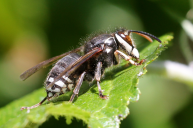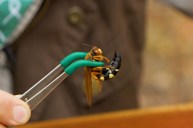The Tarantula Hawk is the type of bug nightmares are made from.
There has been a ton of hype over stinging insects in the media right now. No doubt you have heard all the buzz (pun intended) over the Asian giant hornet, aka: the "Murder hornet." It seems like people are a little on edge right now due to the coronavirus pandemic and maybe that is why they are more apt to freak out when they hear a bug like this is "invading" North America.
Coyote Peterson, who is famous for purposely taking some of the worst insect stings on the planet noticed this and has been trying to dispel some of the rumors by giving hard facts on these bugs. He did it for the Asian giant hornet and now he is doing it for "Spider-Murdering wasps."
Of course, that is just a hyped-up name for this insect. Their real name is the Tarantula hawk. This huge, solitary wasp has a life cycle that is equally fascinating and horrifying at the same time.
[embed_recommendtions]
As you can see, the Tarantula hawk seems more like the Xenomorphs in the "Alien" series of films than a real insect here on earth. This solitary wasp lures out tarantulas and other spiders, stuns them with a sting and then lays an egg on the spider's back. When it hatches, the larva eats the spider alive. Crazy stuff. We are glad it only targets spiders!
Of course, the Tarantula hawk's sting is one for humans to avoid regardless. The good news is, even though the sting is rated among the most painful on earth, it is rarely dangerous. Unlike the Asian giant hornet, there has not been a confirmed case of this insect's sting killing a person.
As Coyote mentioned, this insect is native, so there is no need to worry about an invasion of them. These insects are already here. Fortunately, they will not bother humans unless harassed.
For more outdoor content from Travis Smola, be sure to follow him on Twitter and check out his Geocaching and Outdoors with Travis YouTube channels.
NEXT: VENOMOUS SNAKES IN TEXAS: HOW TO SPOT THE LONE STAR STATE'S DANGEROUS SERPENTS
WATCH





